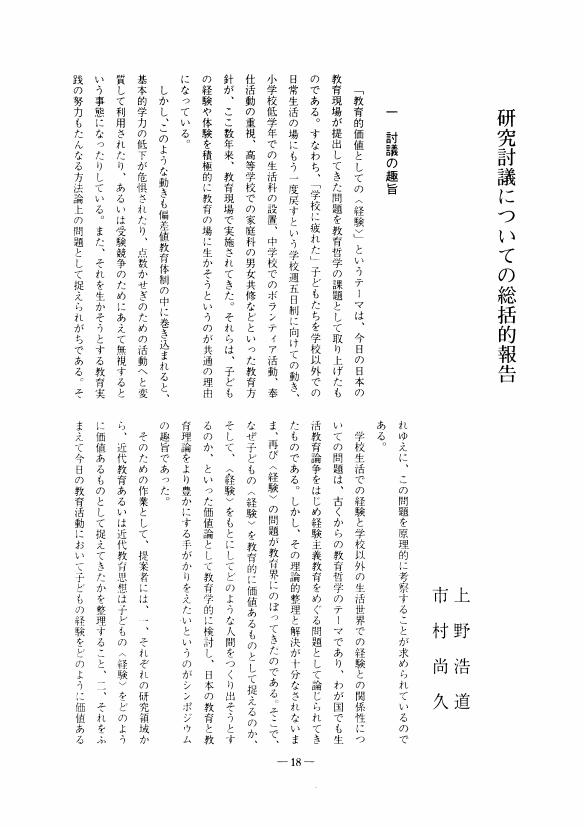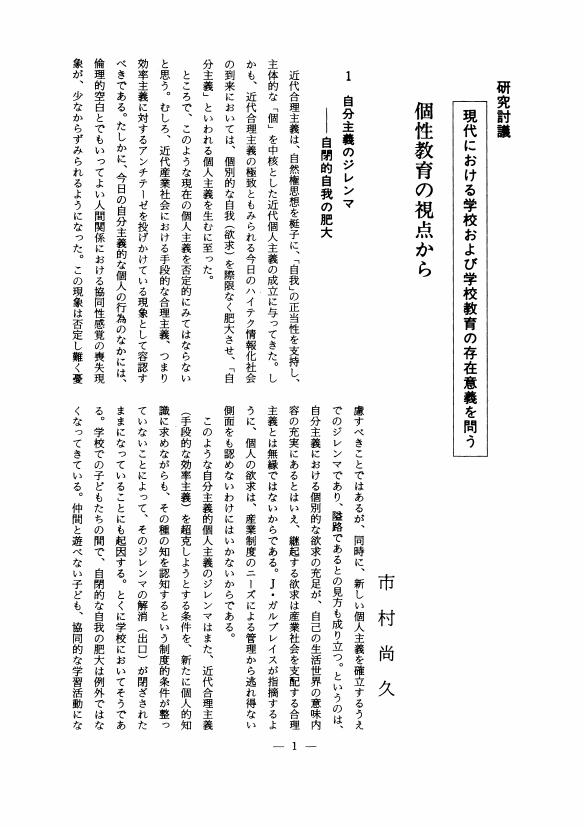1 0 0 0 OA 齋藤直子著『内なる光-デューイとエマソンにおける道徳的完成主義の教育』
- 著者
- 市村 尚久
- 出版者
- 教育哲学会
- 雑誌
- 教育哲学研究 (ISSN:03873153)
- 巻号頁・発行日
- vol.2006, no.94, pp.98-113, 2006-11-10 (Released:2009-09-04)
- 参考文献数
- 18
久々にスケールの大きな、しかも読み応えのある力作に出会った。アメリカ教育哲学の新たな在り方を視野に入れて、デューイ自然主義成長論の再解釈を試みた論考をこれから紹介する。齋藤直子により、この書評の主題のように英文で書かれ、アメリカで刊行された近著である。本書の主題および各章の日本語標記は、著者自身によるものであることをはじめに断っておきたい。本書『内なる光-デューイとエマソンにおける道徳的完成主義の教育』は、アメリカ哲学界で、アメリカの哲学叢書としてフォーダム大学出版部から叢書第十六番目の一巻として二〇〇五年に刊行された単著である。著者は本書がこのような専門学術書としてアメリカで上梓されるに至るまで、本書に関連する相応の研究業績を挙げられてきたという研究歴をもっている。そのことは本稿の後段で紹介し、具体的な関連論文名は本稿の末尾に列挙することとして、先ずは本書の形式的な構成から示したい。
1 0 0 0 OA 教育実践理論への「超越論」的視座
- 著者
- 市村 尚久
- 出版者
- 教育哲学会
- 雑誌
- 教育哲学研究 (ISSN:03873153)
- 巻号頁・発行日
- vol.2001, no.84, pp.104-116, 2001-11-10 (Released:2009-09-04)
哲学にとってまことに不面目なことは、初めから人間と世界との間には裂け目が存在するものと、これまで誰もが真面目に信じてきたということである。生きられた現実のなかでは、こうした裂け目は擬似問題である。-L・H・トルートナー「ジョン・デューイと実存的現象学者」-
1 0 0 0 OA 戦後教員養成理念の推移をめぐる問題点と課題
- 著者
- 市村 尚久
- 出版者
- 教育哲学会
- 雑誌
- 教育哲学研究 (ISSN:03873153)
- 巻号頁・発行日
- vol.1999, no.79, pp.1-5, 1999-05-10 (Released:2009-09-04)
1 0 0 0 OA 研究討議についての総括的報告
- 著者
- 上野 浩道 市村 尚久
- 出版者
- 教育哲学会
- 雑誌
- 教育哲学研究 (ISSN:03873153)
- 巻号頁・発行日
- vol.1995, no.71, pp.18-22, 1995-05-10 (Released:2009-09-04)
1 0 0 0 OA 研究討議の概要報告
- 著者
- 市村 尚久 原 聡介
- 出版者
- 教育哲学会
- 雑誌
- 教育哲学研究 (ISSN:03873153)
- 巻号頁・発行日
- vol.1993, no.67, pp.16-21, 1993-05-10 (Released:2009-09-04)
1 0 0 0 OA 上田 薫著『人間 その光と影-やわらかさを育てる-』 『教育をゆがめるものはなにか』
- 著者
- 市村 尚久
- 出版者
- 教育哲学会
- 雑誌
- 教育哲学研究 (ISSN:03873153)
- 巻号頁・発行日
- vol.1988, no.58, pp.89-94, 1988-11-10 (Released:2009-09-04)
1 0 0 0 OA 個性教育の視点から
- 著者
- 市村 尚久
- 出版者
- 教育哲学会
- 雑誌
- 教育哲学研究 (ISSN:03873153)
- 巻号頁・発行日
- vol.1989, no.59, pp.1-4, 1989-05-10 (Released:2009-09-04)
1 0 0 0 OA 教育哲学を考える
- 著者
- 市村 尚久
- 出版者
- 教育哲学会
- 雑誌
- 教育哲学研究 (ISSN:03873153)
- 巻号頁・発行日
- vol.1988, no.57, pp.82-83, 1988-05-10 (Released:2009-09-04)
1 0 0 0 OA 「擬似個性的人間像の誕生」の視点から
- 著者
- 市村 尚久
- 出版者
- 教育哲学会
- 雑誌
- 教育哲学研究 (ISSN:03873153)
- 巻号頁・発行日
- vol.1983, no.47, pp.30-34, 1983-05-15 (Released:2009-09-04)
- 参考文献数
- 2
1 0 0 0 OA アメリカの教育学研究の一側面 教育の哲学的研究動向を中心に
- 著者
- 市村 尚久
- 出版者
- 教育哲学会
- 雑誌
- 教育哲学研究 (ISSN:03873153)
- 巻号頁・発行日
- vol.1982, no.46, pp.62-68, 1982-11-15 (Released:2009-09-04)
1 0 0 0 OA 二十世紀の子どもと「しつけ」 近代的児童観と教育にみる「助力」と「介入」の思想をふまえて
- 著者
- 市村 尚久
- 出版者
- 教育哲学会
- 雑誌
- 教育哲学研究 (ISSN:03873153)
- 巻号頁・発行日
- vol.1980, no.41, pp.6-10, 1980-04-25 (Released:2009-09-04)
1 0 0 0 OA エマソンにおける「児童尊重」の思想 その本質と独自性
- 著者
- 市村 尚久
- 出版者
- 教育哲学会
- 雑誌
- 教育哲学研究 (ISSN:03873153)
- 巻号頁・発行日
- vol.1977, no.36, pp.1-20, 1977 (Released:2009-09-04)
- 参考文献数
- 69
Emerson's transcendentalism requires throughout as ideal image an individual self-content and self-respecting. This claim is strongly reflected also in his view on education (the child), it aims at a point where it becomes a “postulate” of perfect “respect for the child”, and the purpose of this paper is to examine the nature and the basis of that “postulate”. From the fact that Emerson's view of “respect for the child” is quoted extensively as a principle to corroborate Dewey and Parkhurst it my be inferred that these ideas form a starting point of American progressivism and child-centered education.When the “depth” of Emerson's view is examined analytically along the lines of the method of his thinking (“encounter” and “intuition”) in order to clarify the essence and the peculiar character of Emerson's “Respect for the Child”, it turns out that its acme is the world of “reason, i.e. spirit”. This is an understanding of an extremely symbolic (abstract) nature containing at the same time a universal (truth) meaning, hence on the contrary it has been observed that Emerson's postulate of “respect for the child” contains a hidden radical meaning. When one reflects on the underlying reason, the conclusion is that this postulate possesses an ethical character and that the nature (soul) of the “ideal” is typically American.
1 0 0 0 OA 宇佐美寛著『ブロンスン・オルコットの教育思想』
- 著者
- 市村 尚久
- 出版者
- 教育哲学会
- 雑誌
- 教育哲学研究 (ISSN:03873153)
- 巻号頁・発行日
- vol.1976, no.33, pp.81-87, 1976-05-10 (Released:2009-09-04)
1 0 0 0 OA エマソンの教育思想研究序説 『教育論』における彼の教育観を中心に
- 著者
- 市村 尚久
- 出版者
- 教育哲学会
- 雑誌
- 教育哲学研究 (ISSN:03873153)
- 巻号頁・発行日
- vol.1968, no.18, pp.34-51, 1968-10-20 (Released:2009-09-04)
- 参考文献数
- 66
Emerson appeared on the scene of American social and cultural history not as a representative of educational philosophy but as a great thinker of the New England school of transcendental thought. While he is the author of an essay “Education”, the foundations of his thought must be sought in the development of his ideas which are to be found in his representative works as a philospher of transcendentalism and are incorporated in his books “Nature”, “The American Scholar”, “Spiritual Laws”, “Self-Reliance”, “Over-Soul”, etc. Hence in this paper we shall clarify the methodological characteristics of Emerson's way of thinking in terms of Emerson's thought in general, i. e. his “intuition”. Furthermore the investigation starts by examining the way in which he interprets “nature”. We have tried to clarify the nature of the goal and method of education of “Man” in Emerson's thought, using as an approach to this problem his educational philosophy as it is by way of conclusion expressed in his “Education”. In doing so we have always endeavoured to discuss the problem within the framework of Emerson's system of thought as a whole. While proceeding on the road of an integrated study of Emerson's educational thought we were able to indicate some problems which still wait for a solution, such as; the influence on Emerson's thought by Russell, Pestalozzi etc. ; the roll Emerson's thought played in the development of “The New Education” based on the principle of pragmatism etc.
1 0 0 0 OA キルパトリックの学習論における人格形成の場 その無意識性について
- 著者
- 市村 尚久
- 出版者
- 教育哲学会
- 雑誌
- 教育哲学研究 (ISSN:03873153)
- 巻号頁・発行日
- vol.1965, no.12, pp.61-74, 1965 (Released:2009-09-04)
- 参考文献数
- 34
The present article tries, through analysing the structure of Kilpatrick's theory of learning, to clarify how the character or personality as we speach of character-building or personality-building and the field of building can be recognized. Especially his theory of attitude-building (“attitude” forms the nucleus of the personality structure which is defined as character structure and as individual character trait, and is the field capable of being built) in the field of concomitant learning had induced the present writer to develop the following reasoning.The situation of character-building is the field of active ego-alter relation and falls beyond the direct range of the subject's consciousness. In other words the person concerned is incapable of being conscious of the process of his own character-building but can understand it only reflectively afterwards. The peculiarity of the field of character-building lies in the fact that the person concerned remains unconscious during the process. The concept “unconsciousness” will be the key to the problem of character-building. At the same time the essential nature of the field of character-building could be said to consist in its unconscious building power.
1 0 0 0 OA キルパトリック教育理論におけるプロジェクト法の位置
- 著者
- 市村 尚久
- 出版者
- 教育哲学会
- 雑誌
- 教育哲学研究 (ISSN:03873153)
- 巻号頁・発行日
- vol.1962, no.7, pp.14-30, 1962-10-30 (Released:2009-09-04)
- 参考文献数
- 40
My chief effort in this essay is to interpret faithfully the methodology of “life learning” as displayed in the “project method.” I have tried to understand the “project mothod” as a generalized methodology of problem solving as I subject to reexamination the tendency of some to find a weakness in the spiritual aspects of problem solving, which is considered as the point at issue in interpretations of the “project method” given heretofore. Further, with the help of my interpretation of “concomitant learning, ” I have considered with what meaning the methodology based on the “project method” is given a central place in Kilpatrick's systematic educational theory. I interpret the “project method, ” as we see it developed in the essay, “Project Method, ” as Kilpatrick's methodolgy in matters educational and try to develop the argument that its role is pivotal in Kilpatrick's systematic educational theory.
1 0 0 0 OA ロバート・M・ハッチンズ「教育における葛藤」
- 著者
- 市村 尚久
- 出版者
- 教育哲学会
- 雑誌
- 教育哲学研究 (ISSN:03873153)
- 巻号頁・発行日
- vol.1960, no.3, pp.79-82, 1960 (Released:2009-09-04)










